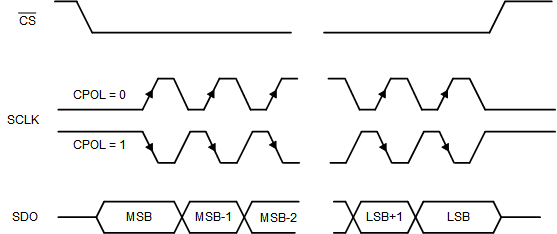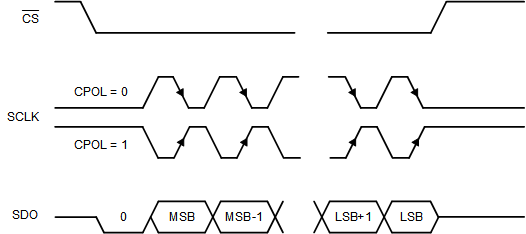ZHCSLR7B March 2021 – September 2024 ADS7067
PRODUCTION DATA
- 1
- 1 特性
- 2 应用
- 3 说明
- 4 Pin Configuration and Functions
- 5 Specifications
-
6 Detailed Description
- 6.1 Overview
- 6.2 Functional Block Diagram
- 6.3 Feature Description
- 6.4 Device Functional Modes
- 6.5 ADS7067 Registers
- 7 Application and Implementation
- 8 Device and Documentation Support
- 9 Revision History
- 10Mechanical, Packaging, and Orderable Information
6.3.10.1 Enhanced-SPI Interface
The device features an enhanced-SPI interface that allows the host controller to operate at slower SCLK speeds and still achieve full throughput. As described in Table 6-5, the host controller can use any of the four SPI-compatible protocols (SPI-00, SPI-01, SPI-10, or SPI-11) to access the device.
Table 6-5 SPI Protocols for Configuring the Device
| PROTOCOL | SCLK POLARITY (At the CS Falling Edge) | SCLK PHASE (Capture Edge) | CPOL_CPHA[1:0] | DIAGRAM |
|---|---|---|---|---|
| SPI-00 | Low | Rising | 00b | Figure 6-5 |
| SPI-01 | Low | Falling | 01b | Figure 6-6 |
| SPI-10 | High | Falling | 10b | Figure 6-5 |
| SPI-11 | High | Rising | 11b | Figure 6-6 |
On power-up, the device defaults to the SPI-00 protocol for data read and data write operations. To select a different SPI-compatible protocol, program the CPOL_CPHA[1:0] field. This first write operation must adhere to the SPI-00 protocol. Any subsequent data transfer frames must adhere to the newly-selected protocol.

(CPHA = 0)

(CPHA = 1)